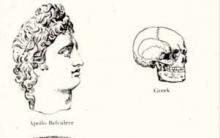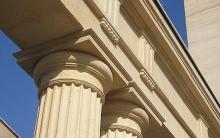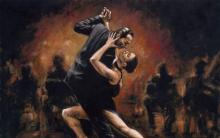Name "small capital" comes from Latin "head, top", which corresponds to the actual location of this part. The capitals were not just a decoration of the column, but also took on the weight of the beams or floors, which increased the strength of the structure as a whole.
A small capital consists of:
- echina - profile bead,
- abacus - top square slab.
Appearing in ancient times, column orders formed into styles, which in turn provided the basis for the development of modern features of the appearance of capitals and other column details.
The undoubted classics are Greek orders, including:
- melancholy,
- doric,
- ionic,
- corinthian.
Doric order differs from others in simplicity and brevity, as a rule, Doric capitals consist of two parts - a rounded echin and a rectangular abacus.
Ionian capitalit had specific curls of decor on the sides - volutes, and also its feature was a strip with an ornament - kimatii. The relief ornament is a characteristic feature of the Ionic capital, like the curls. This order embodies gracefulness and refinement, lightness of forms.


Bright line Corinthian order - capital in the form of a fruit or flower basket. The floral ornament repeated the features of the leaves of burdock and acanthus, and not only on the obverse, which can be considered a sign of the Corinthian order. We will not exaggerate if we say that this order is the brightest and most magnificently decorated.
Tusky - the ancient Roman version of the Greek Dorin order. The peculiarity of the capitals of the depressed order is massiveness, the visual heaviness of the elements, a minimum of decor.


The Romans also created and composite order, taking as a basis the features of the Ionic and Corinthian. On the Corinthian capital, volutes of the Ionic order, as well as additional sculptural details, appeared.



Byzantine capitalcharacterized by clear edges, integrity, small size. In terms of aesthetics and technology, Byzantine capitals are unparalleled. In Byzantium, it was believed that creating a capital is like giving birth to a work of art. That is why Byzantine capitals are particularly luxurious.
Gothic capital was built, as a rule, in Western Europe in the Middle Ages. The Gothic capital is easily recognizable - its upper part is decorated with rounded patterns and leaves. The overall tandem resembles a natural form on which ornamental plants are located.


Modern capitals
Contemporary architectural art in no way denies the classic columns with expressive capitals and reliable bases. Luxurious mansions are decorated with aristocratic columns, which emphasize the taste and status of the inhabitants of the house.

Modern architects and designers often introduce such an element as a capital when building houses and designing interiors for them. Capitals usually decorate rooms and facades where there are columns. But there are also more interesting incarnations - for example, lighting fixtures in the form of capitals. In this case, they fulfill an exclusively aesthetic mission, giving the interior a touch of grandeur and luxury.
Ushakov's Dictionary
Small capital
drip, capitals, wives (lat. capitellum).
1. The upper part of the column, serving as a direct transition to the coating ( architect.).
2. only units A font from letters in size to lowercase, and style to uppercase ( a type.).
Culturology. Dictionary-reference
Small capital
(lat. capitellum - head) - the crowning part of a column, pillar or pilaster.
Architectural vocabulary
Small capital
(from late lat. capitellum - head)
in architecture, a plastically highlighted crowning part of a vertical support (pillar or column), which transfers to it the load from the architrave and parts of the building located above (or figuratively expresses this function, as, for example, in a pilaster). Various types of capitals have developed in the wooden and stone architecture of various peoples, starting with the architecture of the countries of the Ancient East. In the ancient era, three main classical types of capitals emerged that became widespread in European architecture - Doric, Ionic and Corinthian, as well as a composite capital, which is a combination of elements of the Ionic and Corinthian capitals. Unique types of capitals were created in China, Japan, Mexico, in Byzantine, Romanesque, Gothic and Old Russian architecture, in the architecture of Armenia, Georgia, and the states of Central Asia. Since the Renaissance, the types of antique capitals have varied widely, sometimes combinations of classical forms with local ornamental motives have been used.
the upper final part of a column, pylon or pilaster.
(Architecture: An Illustrated Handbook, 2005)
The crowning element of a column or pilaster, which differs from its main part in a more complex shape and greater width.
(Terms of Russian architectural heritage. Pluzhnikov V.I., 1995)
(late lat. capitellum - head) - the crowning part of the vertical support (columns or pilasters), on which the horizontal overlap lies (architrave beam). Various types of capitals were formed in the most ancient wooden structures and in the stone architecture of the countries of the Ancient East (gatoric, lotus, osiric, stalactite, chippolin, etc.). The capital received detailed development in order system antique architecture. The most simple, doric capital includes a rounded pillow - echinus and a square slab lying on it - abacus... More complex, ionic, the capital has a pillow with side curls - volutes and ornamentation of echinus and abacus. Corinthian the capital looks like a lush bowl of acanthus leaves and curls expanding upward. The combination of Ionic and Corinthian capitals gives composite capital, applied for the first time in the architecture of Dr. Rome.
(Dictionary of architecture terms. Yusupov E.S., 1994)
The ancient world. Dictionary-reference
Small capital
(from late lat. capitellum - head)
the crowning part of the column, located between the support shaft and the horizontal ceiling.
(IA Lisovy, KA Revyako. The Ancient World in Terms, Names and Titles: Dictionary-Reference Book on the History and Culture of Ancient Greece and Rome / Scientific Ed. AI Nemirovsky. - 3rd ed. - Minsk: Belarus, 2001)
the upper part of a column or pilaster, on which the floor rests (see Order)
(Ancient culture: literature, theater, art, philosophy, science. Dictionary-reference book / Under the editorship of V.N. Yarho. M., 1995.)
Scythians. Byzantium. Black Sea region. Dictionary of Historical Terms and Names
Small capital
(lat. capitellum "head") the pommel of the column, on which lay the architrave - a beam supporting the roof of the building. The capital could be of different styles (orders): Doric, Ionian, Corinthian and composite, that is, mixed (most often Ionic and Corinthian, as well as with the inclusion of curly elements, for example, ram heads).
encyclopedic Dictionary
Small capital
(from late Lat. capitellum - head), the crowning part of a column, pillar or pilaster.
Ozhegov Dictionary
CAPIT EL [t eh ], and, g. (specialist.). The crowning part of a column, pillar or pilaster.
caput - head) - the crowning part of a column or pilaster. The upper part of the capital protrudes beyond the column, providing a transition to the abacus, which is usually square in shape.Small caps in architectural orders
Used in many architectural styles dating back to ancient Egypt and antiquity. The capitals of Egyptian columns were usually decorated with stylized flowers or papyrus buds. There were also lotus-shaped capitals and columns with capitals in the form of stylized palm leaves.
 The small caps of the three classical orders have a characteristic, easily recognizable shape. Doric capital (1 in the picture) - a simple round echin pillow; at the Ionic capital (2) - two curls-volutes are sculpted on the echina; the Corinthian capital (3) is a tall bell-shaped detail decorated with swirls of acanthus leaves. The composite capital is a synthesis of Ionic and Corinthian.
The small caps of the three classical orders have a characteristic, easily recognizable shape. Doric capital (1 in the picture) - a simple round echin pillow; at the Ionic capital (2) - two curls-volutes are sculpted on the echina; the Corinthian capital (3) is a tall bell-shaped detail decorated with swirls of acanthus leaves. The composite capital is a synthesis of Ionic and Corinthian.
Capital in modern construction
In modern architecture, a capital is also called a part of a monolithic, prefabricated or prefabricated monolithic frame, resting on the body of the column and designed to perceive the supporting moments from the overlying floor and reduce the risk of its destruction as a result of punching.
see also
Write a review on the article "Small capital"
Links
Excerpt characterizing Small caps
Murat moved up to the translator and told him to ask where the Russian troops were. One of the Russian people understood what was being asked of him, and several voices suddenly began to answer the translator. A French officer from the vanguard drove up to Murat and reported that the gates to the fortress were sealed and that there was probably an ambush there.“All right,” said Murat, and, turning to one of the gentlemen of his retinue, ordered to put forward four light guns and fire at the gate.
The artillery trotted out from behind the column following Murat and rode along the Arbat. Having gone down to the end of Vzdvizhenka, the artillery stopped and lined up on the square. Several French officers were in charge of the cannons, placing them, and looking into the Kremlin through the telescope.
In the Kremlin the bells rang for Vespers, and this ringing confused the French. They assumed it was a call to arms. Several infantry soldiers ran to the Kutafyevsky gate. At the gate lay logs and boards. Two rifle shots rang out from under the gate as soon as the officer and his team began to run up to them. The general, who was standing at the cannons, shouted command words to the officer, and the officer with the soldiers ran back.
Three more shots were heard from the gate.
One shot struck a French soldier in the leg, and the strange cry of a few voices was heard from behind the shields. On the faces of the French general, officers and soldiers at the same time, as if on command, the former expression of gaiety and calm was replaced by a stubborn, concentrated expression of readiness for struggle and suffering. For all of them, from the marshal to the last soldier, this place was not Vzdvizhenka, Mokhovaya, Kutafya and Trinity Gates, but this was a new area of \u200b\u200ba new field, probably of a bloody battle. And everyone prepared for this battle. The screams from the gates died away. The guns were extended. The artillerymen blew off the burnt-out blazers. The officer commanded "feu!" [fell!], and the two whistling sounds of cans rang out one after the other. Card bullets crackled against the stone of the gate, logs and shields; and two clouds of smoke wavered in the square.
(from the Latin capitellum - head) part of the order - the upper element of the column or pilaster, located between the fust (the column of the column) and the entablature (horizontal overlap) or the fifth arch, vault. At the bottom, the column is framed by a base. Most often it is column capital... The upper part of the capital (the tops of the column), which creates a visual transition from the vertical of the column to the horizontal of the ceiling, is called an abacus. The architectural design differs depending on the style of the building.
Types of small caps by style
Column capitals of various orders differ in appearance. Small capitals doric order (from the Greek dorikos - by the name of the tribe) of one of the oldest orders of ancient architecture, the simplest, characteristically wide and consist of two parts: a stone "pillow" - and a square slab -.
Ionian capital (Latin ionica - by the name of the Ionian tribe) differs from the Doric by the presence of two volutes (an architectural detail in the form of a spiral curl) on the sides. The Ionian order is the embodiment of light, graceful, sophisticated and feminine style.
Corinthian order (from the name of Corinth in Greece) one of the three classical ancient Greek architecture has a magnificent column capital, reminiscent of a basket with acanthus leaves.
And the architecture of Ancient Rome was developed composite order (Italian composite, Latin сompositum - composite, complex) based on Corinthian and Ionic. They took a Corinthian capital with acanthus leaves decor as a basis and added curls of a volute of an Ionic capital and other sculptural details.
Tuscan order (after the name of the central region of Italy - Tuscany) the ancient Roman version of the Greek Doric order, is the simplest, most powerful, heavy of the five orders. The capital of the column of the Tuscan order is similar to the capital of the column doric order.
Features of the column capital in modern architecture
The artistic image of modern building architecture, which wants to recreate the atmosphere of the classics, uses the capital of classical orders as an element of decorative design of the facades of buildings and interiors.
In the vastness of the Internet, sometimes you can come across the question - what is a small cap in the door? Indeed, now many manufacturers began to decorate columns with this element (cashing). It looks really impressive, but the price is appropriate ...
Definition
Small capital - (architectural, in "Latin - caput", translated as - "head"), this is the upper part of the column, which is located on top and goes beyond it. In architecture, it carried not only decorative and purely practical significance, when it was applied, the load that the support could withstand increased. Such solutions have been used since ancient Egypt and Antiquity, to this day.
In the door
Of course, guys, we are not in ancient Egypt. Nowadays, these capitals are in vogue; in the modern world, they began to decorate door casings. Thus, imitating columns or pilasters on which this part is attached from above. It looks very cool and rich.

Personally, I could not resist and succumbed to this trend of fashion. My doors are wooden, on the sides I installed just such a casing with columns, and an upper protruding part. Check out my photos.



Classic style, looks great, especially on a white wall.
Material
These columns are made from different materials. Often pressed paper, rarely wood. Again here is a photo, a little cropping.


The capital itself is almost always made of wood, of course, cheap manufacturers also make it from pressed paper, but its processing will be difficult, it will not be given the same shape as a wooden one, therefore, as a rule, it will be flat and not very beautiful.

How is it attached
The column itself is either nailed to a wooden box, with small furniture nails, like mine.


Either inserted into special phases. However, this is really a rarity, as a rule, such decorative cashing is nailed or glued in 80% of cases.
The capital itself is rigidly glued to the upper part, it sits very firmly, I tried to tear it off, it did not work.

Price
It should be noted that this pleasure is not cheap, one column costs from 2,500 to 7,000 rubles, at least I have never met more expensive. Therefore, such a portal will come out to you in 2500 X 2 \u003d 5000 rubles + the upper part (some call it a "balcony"), another 3000 rubles in total - 8000 rubles, on one side. And if there are two sides, then only cashing - 16,000 rubles, not including the door, box, hinges and handle. These prices are minimal.
Now a small video of my doors, we are watching.











Monday after Easter: what cannot be done on Bright Week?
How to peel pumpkin
Preparations for raising immunity in children: which are effective
Chloe Moretz and Brooklyn Beckham renewed their relationship a year after breaking up
Useful do-it-yourself zucchini face masks